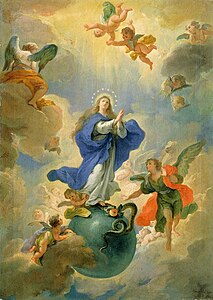|
Bartolomeo Altomonte
 Bartolomeo Altomonte, also known as Bartholomäus Hohenberg (24 February 1694, in Warsaw – 11 November 1783, in Sankt Florian), was an Austrian baroque painter who specialized in large scale frescoes. He was the son of Martino Altomonte, also a painter. BiographyAltomonte was born in Warsaw, where his father, Martino Altomonte, had been appointed to the court of Jan Sobieskis.[1] He was the third of six children. He learned from assisting his father at painting, but also from an apprenticeship with Daniel Gran. He studied with Benedetto Luti in Rome and in Naples with Francesco Solimena. A sketchbook compiled by Altomonte while with Luti is in the Albertina.[2] From 1722 he lived in Austria. Altomonte spent most of his life in Linz and worked primarily in Austrian monasteries such as St. Florian's Priory and Admont Abbey. [3] In 1747 he painted a ceiling fresco for the library at St. Florian's.[4] Other frescoes and altarpieces he painted for the convents of Wilhering, Herzogenburg, for the cathedral of Sankt Pölten, and for churches in Vienna.[5] In Seitenstetten Abbey the frescoes on the Grand Staircase are by Altomonte. Around 1740, he did an oil on canvas painting of the Wunder des heiligen Nikolaus for Neuberg Abbey.[6] Tendencies towards the rococo remained foreign to the artist all his life; he is considered one of the last great painters in the manner of the baroque allegory.[citation needed] Works
ReferencesBibliography
External linksWikimedia Commons has media related to Bartolomeo Altomonte. |
Portal di Ensiklopedia Dunia




